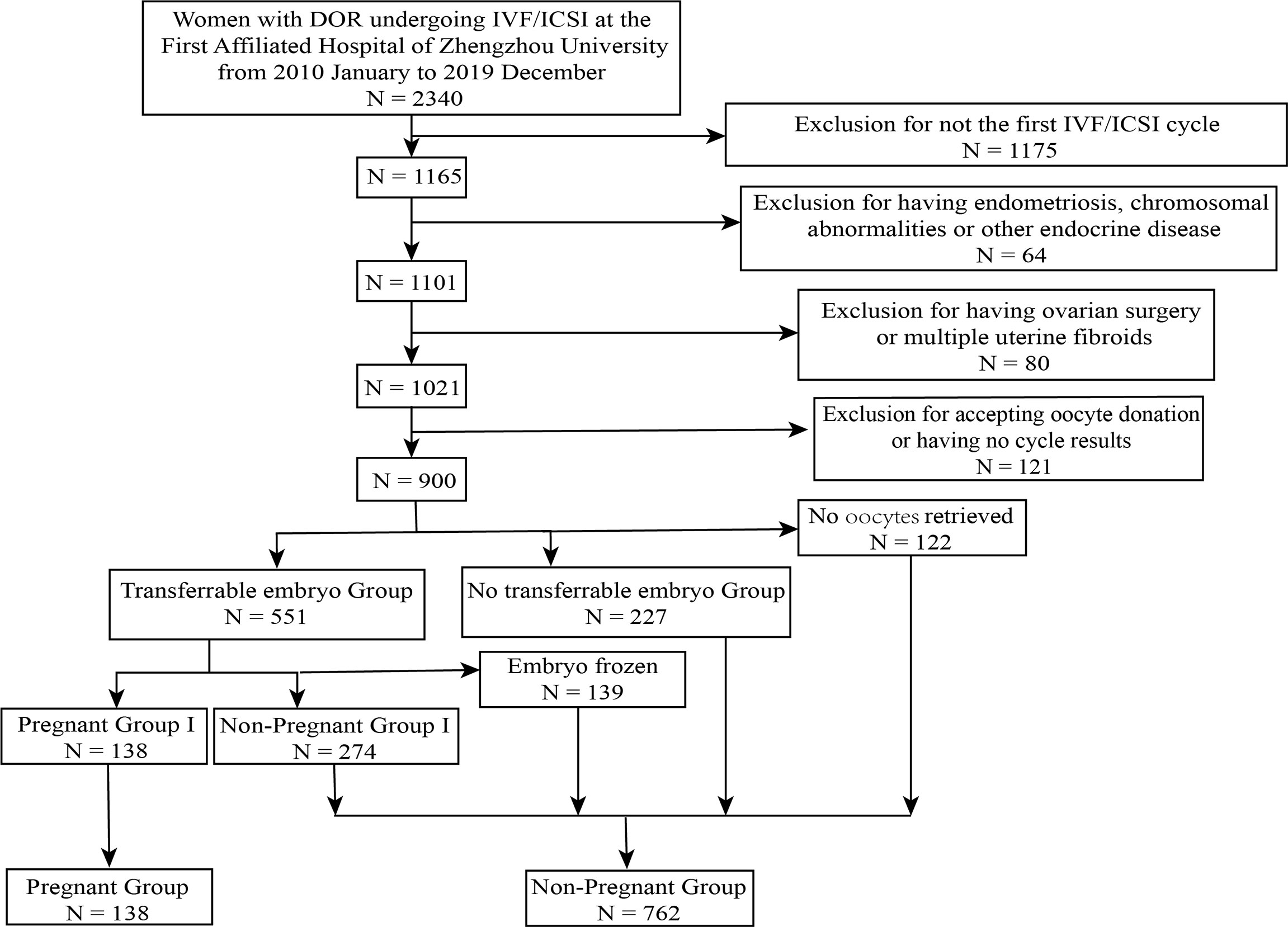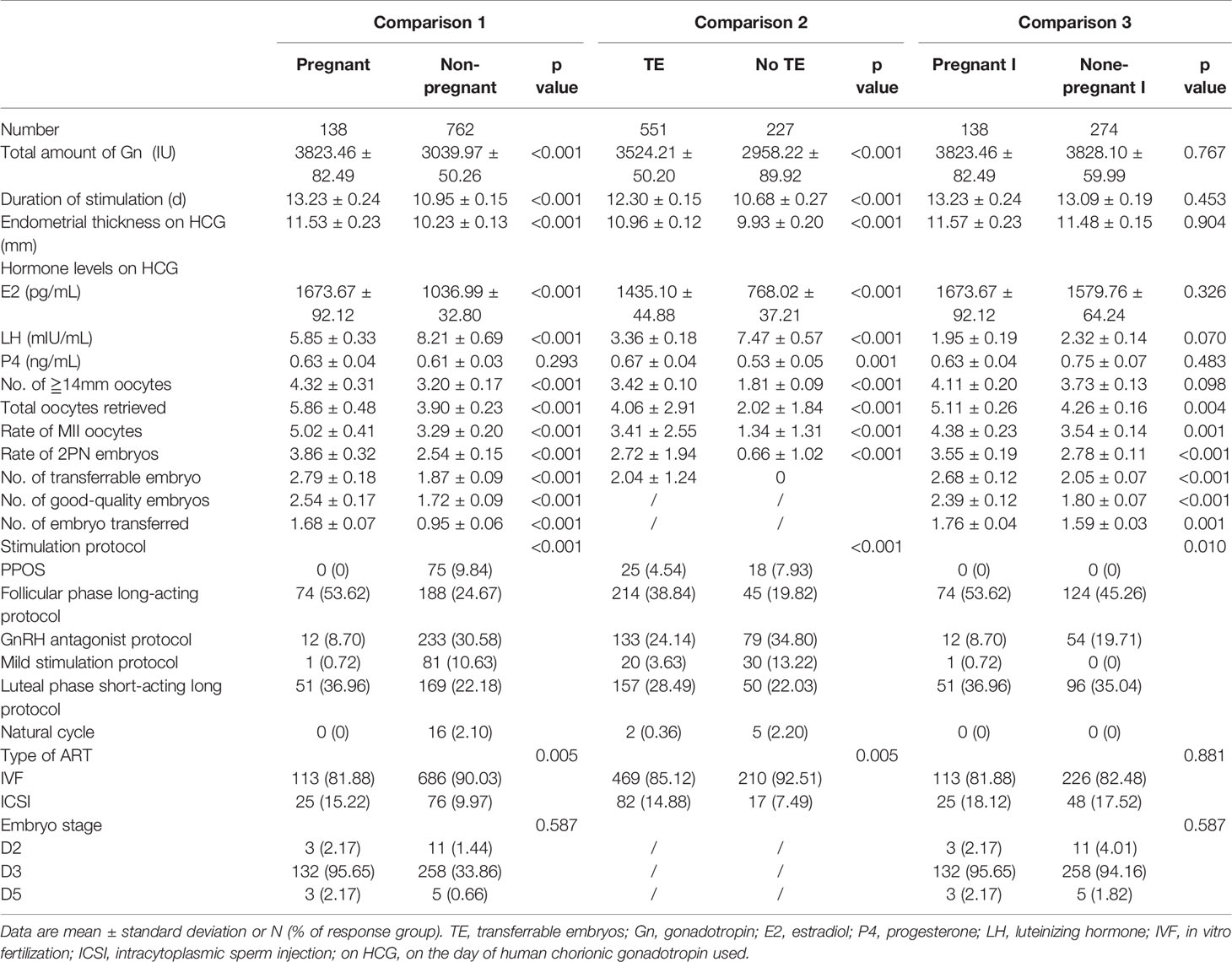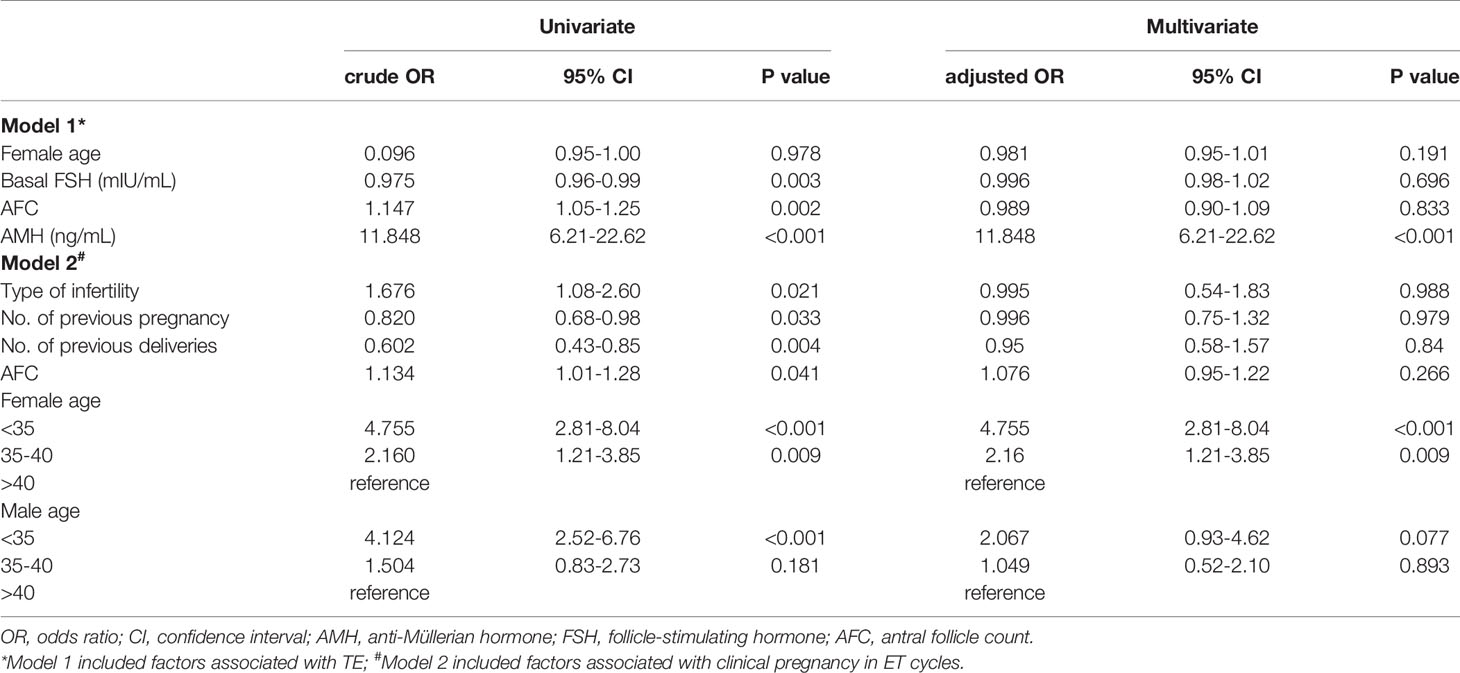- 1Center for Reproductive Medicine, The First Affiliated Hospital of Zhengzhou University, Zhengzhou, China
- 2Henan Key Laboratory of Reproduction and Genetics, The First Affiliated Hospital of Zhengzhou University, Zhengzhou, China
- 3Henan Provincial Obstetrical and Gynecological Diseases (Reproductive Medicine) Clinical Research Center, The First Affiliated Hospital of Zhengzhou University, Zhengzhou, China
- 4Henan Engineering Laboratory of Preimplantation Genetic Diagnosis and Screening, The First Affiliated Hospital of Zhengzhou University, Zhengzhou, China
Introduction: Women with diminished ovarian reserve (DOR) have a lower pregnancy rate and higher cancellation rate compared to those without DOR when seeking assisted reproductive technology. However, which factors are associated with reproductive outcomes and whether AMH is a predictor of clinical pregnancy remain unclear.
Objective: This retrospective study was designed to find factors associated with reproductive outcomes in DOR patients and then discuss the role of AMH in predicting cycle results among this population.
Method: A total of 900 women were included in the study. They were diagnosed with DOR with the following criteria: (i) FSH > 10 IU/L; (ii)AMH < 1.1 ng/ml; and (iii) AFC <7. They were divided into different groups: firstly, based on whether they were clinically pregnant or not, pregnant group vs. non-pregnant group (comparison 1); secondly, if patients had transferrable embryos (TE) or not, TE vs. no TE group (comparison 2); thirdly, patients undergoing embryo transfer (ET) cycles were divided into pregnant I and non-pregnant I group (comparison 3). The baseline and ovarian stimulation characteristics of these women in their first IVF/ICSI cycles were analyzed. Logistic regression was performed to find factors associated with clinical pregnancy.
Results: Of the 900 DOR patients, 138 women got pregnant in their first IVF/ICSI cycles while the rest did not. AMH was an independent predictor of TE after adjusting for confounding factors (adjusted OR:11.848, 95% CI: 6.21-22.62, P< 0.001). Further ROC (receiver operating characteristic) analysis was performed and the corresponding AUC (the area under the curve) was 0.679 (95% CI: 0.639-0.72, P< 0.001). Notably, an AMH level of 0.355 had a sensitivity of 62.6% and specificity of 65.6%. However, there was no statistical difference in AMH level in comparison 3, and multivariate logistic regression showed female age was associated with clinical pregnancy in ET cycles and women who were under 35 years old were more likely to be pregnant compared to those older than 40 years old (adjusted OR:4.755, 95% CI: 2.81-8.04, P< 0.001).
Conclusion: AMH is highly related to oocyte collection rate and TE rate,and 0.355 ng/ml was a cutoff value for the prediction of TE. For DOR patients who had an embryo transferred, AMH is not associated with clinical pregnancy while female age is an independent risk factor for it.
Background
Diminished ovarian reserve (DOR) refers to the reduction of the quantity of oocytes in the ovary, which is one of the major causes of infertility in women of child-bearing age (1). Ovarian surgery and gene mutation may be associated with DOR while most patients with DOR cannot find an identified etiology (2, 3). Patients with DOR have a lower number of oocytes acquired and a rate of high-quality embryos compared to those with normal ovarian reserve (NOR), and the rate of a clinical pregnancy is lower while the early miscarriage rate is higher (4–6). Although various treatments are made to assist them to improve the outcome of pregnancy, it remains a big challenge for clinicians.
Based on the Bologna criteria (7), follicle-stimulating hormone (FSH), anti-mullerian hormone (AMH), and antra follicular count (AFC) are the most frequently used biomarkers to access the ovarian reserve, and the latter two have gained widespread attention in recent years. Generally, AMH levels and AFC decline while the incidence of DOR increases, however, discordance between AFC and AMH levels is not rare in clinical work. Measuring by ultrasound, AFC is highly affected by different machines and operating doctors. Studies have demonstrated that priority should be given to AMH compared to AFC in predicting ovarian marker and fertility (8–10).
Controversy has existed on whether AMH is associated with reproductive outcomes in assisted reproductive technology (ART) cycles. A meta-analysis reviewed 19 articles including unspecified ovarian reserve, DOR, and polycystic ovary syndrome (PCOS) patients. Results showed that AMH had weak association with clinical pregnancy but could be a predictor in DOR women (11). A study analyzed 85,062 fresh and embryo-thawed (ET) cycles and demonstrated AMH cannot be a reliable independent predictor of live birth rate (12).
In this retrospective study, we collected data from the first IVF/ICSI cycles of patients with DOR and analyzed baseline and controlled ovarian stimulation (COS) characteristics to find out factors associated with reproductive outcomes and then discuss the role of AMH in predicting cycle results among this population.
Methods and Materials
Patient Selection
Patients who came to the First Affiliated Hospital of Zhengzhou University for autologous IVF/ICSI cycles were enrolled into this study during January 2011 to December 2019. Patients who have fulfilled the following criteria were included: (i) FSH > 10 IU/L and AMH < 1.1 ng/ml and AFC <7; (ii) the first fresh IVF/ICSI cycle in our center. While the participants who had (i) endometriosis, polycystic ovarian syndrome (PCOS); (ii) chromosomal abnormalities; (iii) hypertension, diabetes, or other chronic diseases; (iv) immune system diseases, such as hypothyroidism; (v) multiple uterine fibroids or a history of ovarian surgery or chemotherapy or radiation exposure; (vi) experienced IVF/ICSI cycles at other hospitals; (vii) premature ovarian insufficiency were excluded (Figure 1) as our purpose was to characterize women with idiopathic decrease in ovarian reserve and eliminate other possible confounding factors that had influence on reproductive outcomes. This study was performed under institutional review board approval.
Grouping Method
A total of 900 patients with DOR were included (Figure 1). To find out factors associated with reproductive outcomes in DOR patients at their first ART cycles, firstly, patients were divided into two groups based on whether they were clinically pregnant or not: pregnant group vs. non-pregnant group (comparison 1); secondly, patients who had transferrable embryos (TE) were compared with those did not: TE vs. no TE group (comparison 2); thirdly, patients undergoing embryo transfer (ET) cycles were divided into two groups: pregnant I and non-pregnant I group (comparison 3). Clinical pregnancy was defined as the following: 35 days after transplantation, transvaginal ultrasound examination showed that there was at least one gestational sac in the uterus, including ectopic pregnancy (13).
AMH Level Detection
Two ml blood samples were aseptically collected from the subjects on days 2 – 4 of the menstrual cycle to assess basal AMH. After centrifugation, serum was analyzed by an electrochemical luminescence analyzer (Roche, Cobas e601, Canada) to detect AMH levels (ng/ml). The theoretical sensitivity of the method was 0.006 ng/ml. Within batches and between batches coefficient of variations were ≤10% and ≤15%, respectively.
Controlled Ovarian Stimulation Protocol
The ovarian stimulation protocol was determined by the ovarian reserve testing (AMH, AFC and basal FSH) of each patient.
Progestin-Primed Ovarian Stimulation Protocol (PPOS)
Medroxyprogesterone acetate and human menopausal gonadotropin (HMG) were used on the third day of menstruation, human chorionic gonadotropin (HCG) was used at the time of triggering.
Follicular Phase Long-Acting Protocol
Patients were given a starting dose of 3.75 mg GnRH agonist (GnRH-a) on the second day of menstruation. Gonadotropins (Gn) were used to induce ovulation, and we adjusted the dose according to the number, size, and growth of the follicles.
Mild Stimulation Protocol
Letrozole was given to patients at a dose of 2.5 mg per day on the third day of menstruation, and HMG was added on the fifth day. Once the diameter of a primary follicle was > 18 mm, HCG and Gn were used.
Natural Cycle
The number, size, and growth of follicles and hormone levels, especially LH, E2, and P4, were observed during menstruation to determine the time of triggering.
Luteal Phase Short-Acting Long Protocol
GnRH-a was used on the 21st day of menstruation, and ultrasound and hormone levels were used to observe the growth of the follicles. Ovulation was induced using HCG according to the size of the follicles.
GnRH Antagonist Protocol
FSH was given to patients on their second day of menstruation, and Gn and HCG were injected when the diameter of the primary follicle was > 18 mm.
In the above protocols, HCG was used for 36-37 h before oocyte retrieval. IVF or ICSI was used according to the semen quality of the husband.
Statistical Methods
The baseline and ovarian stimulation characteristics of patients were compared between each two groups (the grouping method was as described above). Continuous variables were compared by Mann–Whitney U since they were not normally distributed. Chi-squared tests were used to compare categorical variables. The numerical data are presented as the mean with standard deviation (SD), while categorical variables are shown as % (n/N). We performed the univariate and multivariate logistic regression analyses to examine factors that were associated with reproductive outcomes. IBM SPSS version 26.0 (IBM Corp., Armonk, NY, USA) was used, and a P value < 0.05 was considered statistically significant.
Results
Of the 900 patients who met the criteria in the study, 778 (86.44%) women had oocytes retrieved at their first cycle, 551 (61.22%) women had transferrable embryos after egg collection, 139 (15.44%) patients had embryos frozen, and 138 (15.33%) women got pregnant after implantation.
Baseline Characteristics
As shown in Table 1, in comparison 1, both women and their husbands in the pregnant group were younger than those in the non-pregnant group (34.64 ± 0.43 vs. 38.16 ± 0.22, P < 0.001; 35.13 ± 0.51 vs. 38.80 ± 0.24, P < 0.001). Compared to the non-pregnant group, patients in the pregnant group had shorter years of infertility (4.14 ± 0.31 vs. 5.02 ± 0.16, P=0.045) and experienced fewer times of delivery (0.47 ± 0.05 vs. 0.63 ± 0.02, P =0.010); their basal follicle-stimulating hormone (FSH) and luteinizing hormone (LH) levels were much lower (15.23 ± 0.58 vs. 17.46 ± 0.36, P =0.006; 6.17 ± 0.33 vs. 8.10 ± 0.28, P = 0.003) while basal AMH levels and AFC were much higher (0.54 ± 0.02 vs. 0.37 ± 0.01, P< 0.001; 3.70 ± 0.14 VS 2.79 ± 0.07, P< 0.001). There was no significant difference in the type of infertility, number of pregnancy or abortion, body mass index (BMI), basal estradiol (E2), progesterone (P4), testosterone (T) levels, or basal endometrial thickness between two groups.
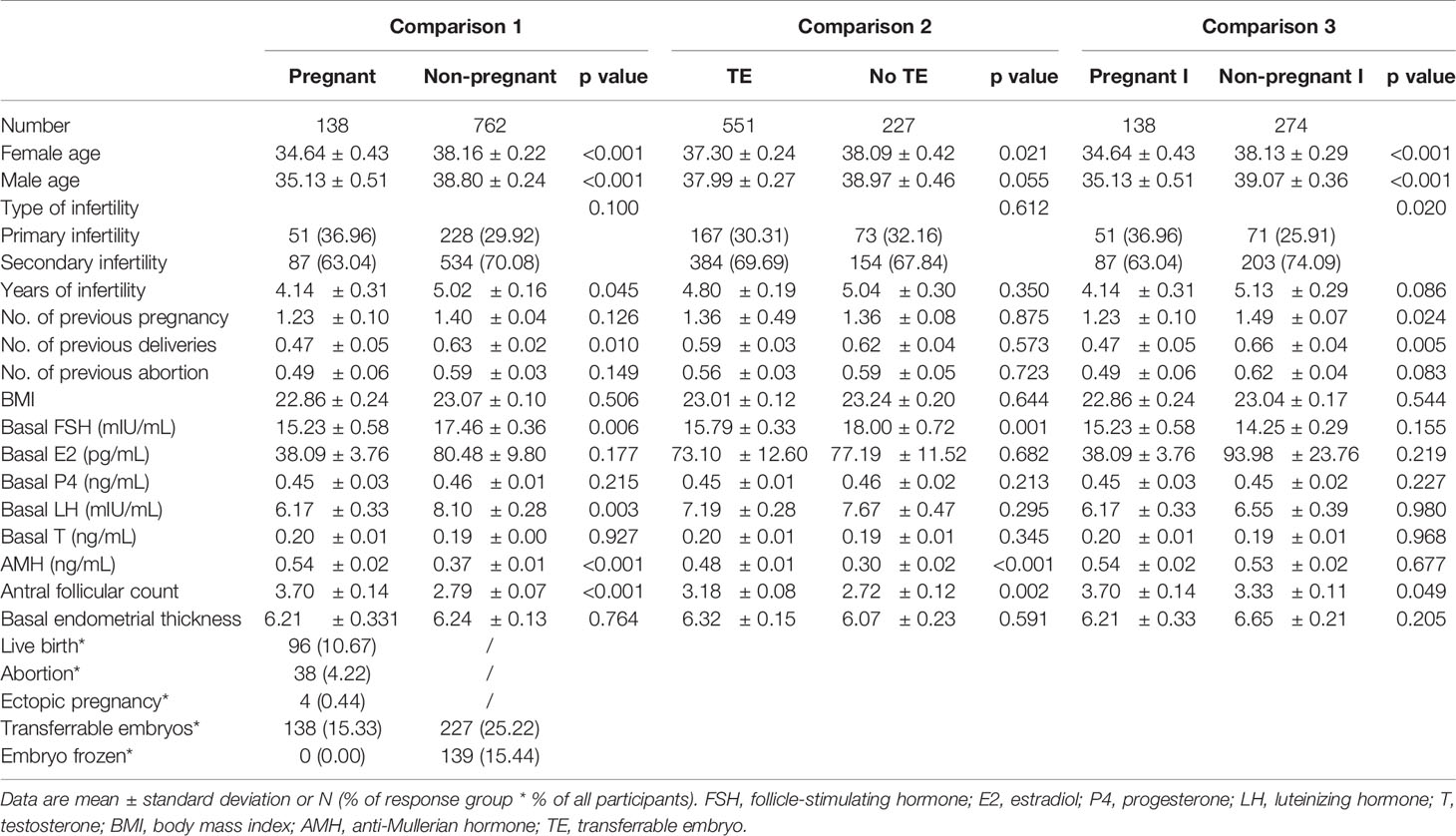
Table 1 Baseline characteristics and hormonal profiles between groups of women with DOR undergoing IVF/ICSI.
In terms of transferrable embryo, only age of female (37.30 ± 0.24 vs. 38.09 ± 0.42, P = 0.021), basal FSH levels (15.79 ± 0.33 vs. 18.00 ± 0.72, P = 0.001), basal AMH levels (0.48 ± 0.01 vs. 0.30 ± 0.02, P < 0.001), and AFC (3.18 ± 0.08 vs. 2.72 ± 0.12, P = 0.002) differed between TE and no TE group. Others were not significantly different.
In comparison 3, FSH (15.23 ± 0.58 vs. 14.25 ± 0.29, P = 0.155) and AMH (0.54 ± 0.02 vs. 0.53 ± 0.02, P = 0.68) had no statistical difference between pregnant I and non-pregnant I group, while AFC (3.70 ± 0.14 vs. 3.33 ± 0.11, P = 0.049) was at the threshold value of P < 0.05. Both maternal (34.64 ± 0.43 vs. 38.13 ± 0.29, P < 0.001) and paternal (35.13 ± 0.24 vs. 39.07 ± 0.36, P< 0.001) age differed significantly between the two groups.
Ovarian Stimulation Characteristics
As shown in Table 2, patients in the pregnant group used more gonadotropin (Gn) and the length of stimulation was much longer than those in the non-pregnant group. In addition, their E2 levels on the day of HCG administration was much higher (1673.67 ± 92.12 vs. 1036.99 ± 32.80, P< 0.001) and the endometrial thickness on that day was much thicker (11.57 ± 0.23 vs. 10.05 ± 0.11, P< 0.001). Not surprisingly, pregnant women had more oocytes retrieved (5.11 ± 0.26 vs. 3.11 ± 0.10, P< 0.001) and had more embryos to implant (2.70 ± 0.14 vs. 1.82 ± 0.07, P< 0.001) compared to women who were not pregnant. Women who were pregnant were more likely to be treated with follicular phase long-acting protocol (74/138 53.62%) and luteal phase ultra-long protocol (51/138 36.96%), however, there was no significant difference in the embryo stage when transferring between two groups.
In comparison 2, the usage of Gn, hormone levels on the day of HCG administration, type of ART, and the choice of stimulation protocol were different between two groups. Due to the difference of protocol choice, more dosage and days of Gn were used in TE group (P < 0.001).
In ET cycles, all patients underwent embryos implantation, number of oocytes (retrieved and MII oocytes, P = 0.004 and 0.001, respectively) and embryos (P < 0.001) differed significantly between pregnant and non-pregnant groups; hormone levels, Gn usage, embryo stage, and type of ART had no significant difference.
Multivariate Logistic Regression and ROC Curve
To find which factors were associated with reproductive outcomes in women with DOR, univariate and multivariate logistic regression analyses were performed (Table 3).
Model 1 included factors associated with TE, and results showed that AMH was an independent predictor of TE after adjusting for confounding factors (adjusted OR:11.848, 95% CI: 6.21-22.62, P< 0.001). Further ROC (receiver operating characteristic) analysis was performed and corresponding AUC (the area under the curve) was 0.679 (95% CI: 0.639-0.72, P< 0.001). Notably, AMH level of 0.355 had sensitivity of 62.6% and specificity of 65.6%. (Figure 2)
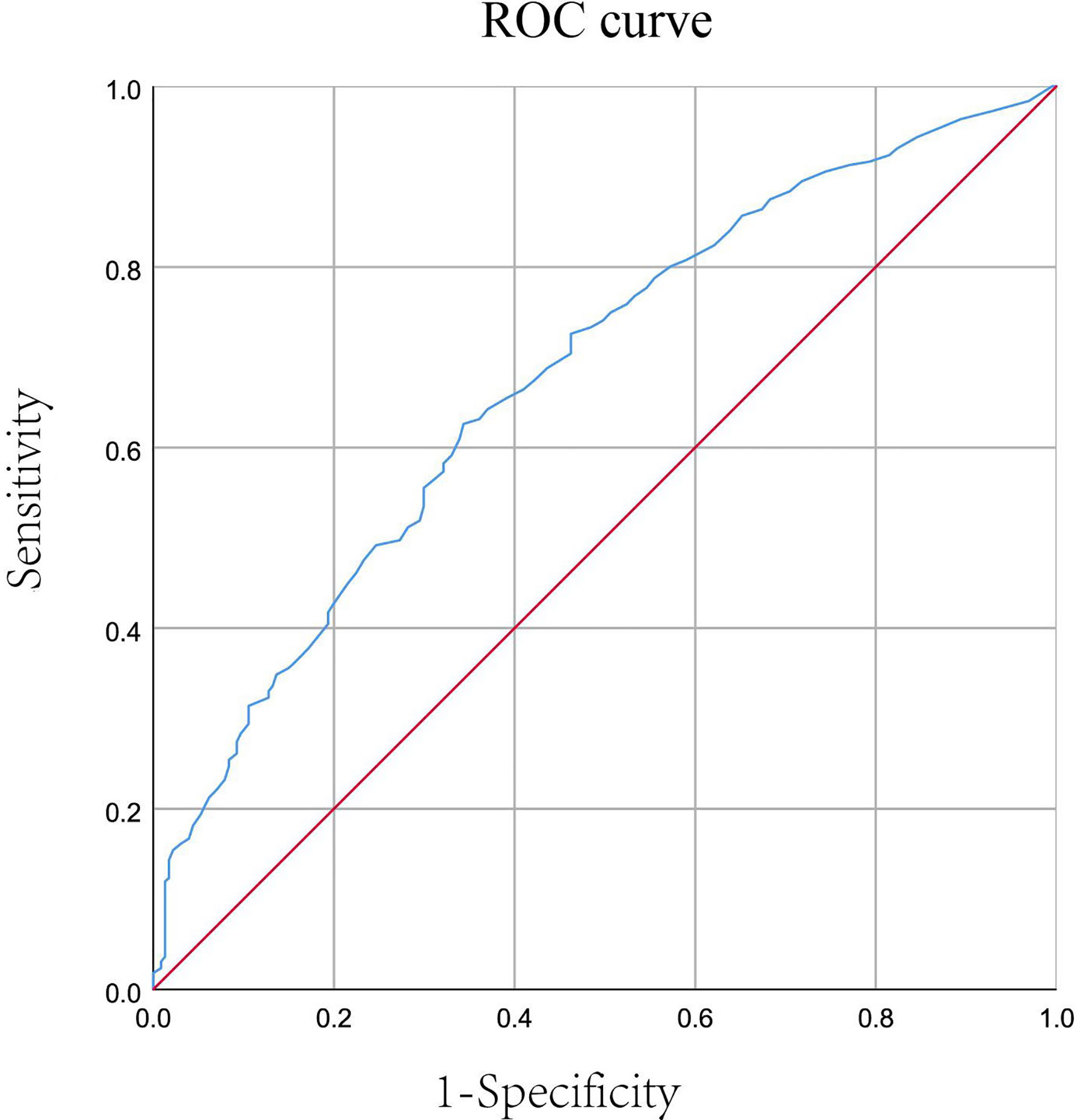
Figure 2 Receiver operating characteristics curve of the predictive utility of AMH for TE among women with DOR (area under the curve (AUC) = 0.679, 95% CI: 0.639-0.72, P < 0.001).
Model 2 included factors associated with clinical pregnancy in ET cycles. Female age was the only factor associated with clinical pregnancy in ET cycles and women under 35 years old were more likely to be pregnant compared to those older than 40 years old (adjusted OR:4.755, 95% CI: 2.81-8.04, P< 0.001).
Discussion
In a woman’s life, the development of follicle pools begin when in utero. However, it begins to decline before the time of birth and continues to decline throughout the fertile years (14). Generally, the ovarian reserve drops sharply in the mid-40s, which is a normal physiological phenomenon. Some women, however, experience DOR long before the usual time, which causes infertility in their child-bearing years (15). DOR has multiple adverse implications for a woman’s health due to the change of ovarian hormones. A previous study demonstrated that it impairs renal function, increases the risk of cardiovascular disease and decreases bone mineral density (4). The most disastrous impact of DOR for a woman, however, may be infertility. With the development of ART, the number of patient visits is increasing rapidly, and about 31%of patients who go to reproductive centers for help have reduced ovarian reserve, and the incidence rises significantly with age (16). However, due to the long period and high cost of IVF/ICSI cycles, patients and families may have heavy burdens after failure, not only economically but also psychologically.
Therefore, we designed this study to find factors that affect fecundity in DOR women. Like previous reports (17, 18), patients were divided into groups based on if they were clinically pregnant in their first IVF/ICSI cycle, and age, AMH, and AFC were highly different between the two groups. Yet many patients (n = 139) had embryoes frozen because of elevated progesterone levels, uterus factor, or self-factors, and they were divided into the non-pregnant group. Biases may exist in the results above. It’s believed that women with higher AMH could have more eggs collect after COS (19). Next, to demonstrate AMH is also associated with the rate of embryo formation after retrieving oocytes, comparison 2 was constructed. Results showed AMH is an independent predictor of TE rate, and 0.355 ng/ml was a cutoff value for the prediction of TE. Last, we wondered if AMH can affect clinical pregnancy after embryo implantation, comparison 3 was made. Not surprisingly, female age is the only factor related to success in ET cycles.
There Is No Best Protocol for DOR Patients Due to the Existence of Huge Individual Differences
Of the 900 women included, 762 women did not conceive. These patients were older and had much lower ovarian reserve according to FSH, AFC, and AMH compared to those who are pregnant. Considering baseline characteristics and poor ovarian response (POR) of these women, appropriate stimulation protocol was selected to avoid the adverse reactions of high-dose exogenous hormones and reduce the economic burden on patients. In COS cycles, patients in the non-pregnant group tended to use GnRH antagonist protocol and Follicular phase long-acting protocol. Natural protocol and mild stimulation protocol were in the non-pregnant group only. Correspondingly, women in non-pregnant group used much lower Gn and got fewer oocytes and embryos. Published data compared various protocols in DOR patients, GnRH agonist protocol and modified natural cycle were thought to be more effective than other protocols, since they could improve the quality of oocytes and probability of live birth of women with DOR (20, 21). The latest meta-analysis does not promote GnRH antagonist protocol for DOR patients because it correlates with higher cancellation rates and less pregnancies compared to agonist protocols (22). Ovarian stimulation protocol choice should be based on physical condition of DOR patients, which may be different each cycle. It is our opinion that there is no best protocol for this population because of the existence of huge individual differences.
AMH Is an Independent Predictor of TE But Not of Clinical Pregnancy in ET Cycles
Produced by developing antral follicles in the ovaries and involved in the regulatory process of maturation of primordial follicles, AMH is considered an accurate biomarker to access ovarian reserve and ovarian response (15, 23). Recent studies tried to find out whether AMH had an association with reproductive outcomes, including rate of oocyte collected, clinical pregnancy, live birth, and miscarriage. A retrospective study reviewed 34,540 cycles with AMH<1 ng/ml and demonstrated serum AMH is highly correlated with cumulative live birth rates (CLBR) in women with DOR independent of age (24). Similarly, AMH was statistically differed between TE and no TE group in our study, and we identified 0.355 ng/ml as a cutoff value for the prediction of TE. Yet it had no correlation with clinical pregnancy in ET cycles, which means the AMH level was not associated with pregnancy rate in patients with implanted embryos. This result is consistent with a previous report (25). The ability of AMH on predicting the likelihood of IVF/ICSI success continues to be a subject of debate. Our study demonstrated that AMH is highly related to the oocyte acquired rate and TE rate but not to the clinical pregnancy rate in ET cycles. Large cohort studies are needed to discuss the relationship between them.
Female Age Is a Risk Factor of Clinical Pregnancy in ET Cycles
Follicles in female ovarian apoptosis and the decrease with increasing of age means the capacity of fertility is dropping over time, therefore, age can largely determine whether conception can be successful. Studies have shown that in DOR patients, younger women have higher pregnancy rate and lower miscarriage rate compared to their older peers (8, 26, 27). Similar results were found in our study. Patients 35-40 years of age were 2.16 times more likely to getpregnant compared to those > 40 years old, and the number increased to 4.755 in patients < 35 years old. Researchers believe that DOR not only has adverse implications on oocyte quantity but also on quality (28). Moreover, data from our center investigated by Zhang et al. (29) showed that the aberration-related miscarriages among women with DOR were more frequent in patients older than 32 years old, and they demonstrated age is an independent risk factor for chromosomal abnormality after adjustment. For those who are diagnosed with DOR, younger women can have better reproductive outcomes with ART compared to older ones. This should be explained to patients so they can get a better understanding of their situation and get anxiety and stress released.
Strength and Limitation
This study has some strengths. First, due to the rigorous definition of DOR, the homogeneity of the patients included was high, and possible confounding factors were removed. Second, we divided the patients into different groups step by step, and deeply explored the relevant factors related to the fecundity of DOR patients. This grouping method is conducive to controlling the influence of confounding factors.
There were also several limitations in our study. One is the nature of the retrospective study. Data from a single center also weakened the reliability. In addition, we only included the first IVF/ICSI cycle of these patients; CLBR were not analyzed. Conception, not live birth, was our main outcome, while live birth is crucial for accessing fecundity. Therefore, the conclusions from this study are not definitive but indicative, and these findings need to be confirmed by more prospective and multi-center studies.
Conclusion
AMH is highly related to oocyte collection rate and TE rateand 0.355 ng/ml was a cutoff value for the prediction of TE. For DOR patients who had embryo transferred, AMH is not associated with clinical pregnancy while female age is an independent risk factor for it.
Data Availability Statement
The original contributions presented in the study are included in the article/Supplementary Material. Further inquiries can be directed to the corresponding author.
Ethics Statement
This study was performed under institutional review board approval of the First Affiliated Hospital of Zhengzhou University
Author Contributions
LL and BS: designed study, analyzed data, and drafted the manuscript. FW and YZ: reviewed the manuscript. YS: Study conceptualization and review. All authors approved the final manuscript.
Funding
This study was supported by Henan Province Medical Science and Technology Research (Key) Project (FDN-SBGJ202002049); Henan Province Medical Scienceand Technology Research Project (FDN-LHGJ20210353).
Conflict of Interest
The authors declare that the research was conducted in the absence of any commercial or financial relationships that could be construed as a potential conflict of interest.
Publisher’s Note
All claims expressed in this article are solely those of the authors and do not necessarily represent those of their affiliated organizations, or those of the publisher, the editors and the reviewers. Any product that may be evaluated in this article, or claim that may be made by its manufacturer, is not guaranteed or endorsed by the publisher.
Supplementary Material
The Supplementary Material for this article can be found online at: https://www.frontiersin.org/articles/10.3389/fendo.2022.796199/full#supplementary-material
References
1. Christodoulaki A, Boel A, Tang M, De Roo C, Stoop D, Heindryckx B. Prospects of Germline Nuclear Transfer in Women With Diminished Ovarian Reserve. Front Endocrinol (Lausanne) (2021) 12:635370. doi: 10.3389/fendo.2021.635370
2. Kitajima M, Khan KN, Harada A, Taniguchi K, Inoue T, Kaneuchi M, et al. Association Between Ovarian Endometrioma and Ovarian Reserve. Front Biosci (Elite Ed) (2018) 10:92–102. doi: 10.2741/e810
3. Jaillard S, Sreenivasan R, Beaumont M, Robevska G, Dubourg C, Knarston IM, et al. Analysis of NR5A1 in 142 Patients With Premature Ovarian Insufficiency, Diminished Ovarian Reserve, or Unexplained Infertility. Maturitas (2020) 131:78–86. doi: 10.1016/j.maturitas.2019.10.011
4. Pal L, Bevilacqua K, Zeitlian G, Shu J, Santoro N. Implications of Diminished Ovarian Reserve (DOR) Extend Well Beyond Reproductive Concerns. Menopause (2008) 15(6):1086–94. doi: 10.1097/gme.0b013e3181728467
5. Morin SJ, Patounakis G, Juneau CR, Neal SA, Scott RT, Seli E. Diminished Ovarian Reserve and Poor Response to Stimulation in Patients <38 Years Old: A Quantitative But Not Qualitative Reduction in Performance. Hum Reprod (2018) 33(8):1489–98. doi: 10.1093/humrep/dey238
6. Fan Y, Chang Y, Wei L, Chen J, Li J, Goldsmith S, et al. Apoptosis of Mural Granulosa Cells Is Increased in Women With Diminished Ovarian Reserve. J Assist Reprod Genet (2019) 36(6):1225–35. doi: 10.1007/s10815-019-01446-5
7. Ferraretti AP, La Marca A, Fauser BC, Tarlatzis B, Nargund G, Gianaroli L. ESHRE Consensus on the Definition of 'Poor Response' to Ovarian Stimulation for In Vitro Fertilization: The Bologna Criteria. Hum Reprod (2011) 26(7):1616–24. doi: 10.1093/humrep/der092
8. Bishop LA, Richter KS, Patounakis G, Andriani L, Moon K, Devine K. Diminished Ovarian Reserve as Measured by Means of Baseline Follicle-Stimulating Hormone and Antral Follicle Count Is Not Associated With Pregnancy Loss in Younger In Vitro Fertilization Patients. Fertil Steril (2017) 108(6):980–7. doi: 10.1016/j.fertnstert.2017.09.011
9. Fleming R, Seifer DB, Frattarelli JL, Ruman J. Assessing Ovarian Response: Antral Follicle Count Versus Anti-Müllerian Hormone. Reprod BioMed Online (2015) 31(4):486–96. doi: 10.1016/j.rbmo.2015.06.015
10. Ligon S, Lustik M, Levy G, Pier B. Low Antimüllerian Hormone (AMH) Is Associated With Decreased Live Birth After In Vitro Fertilization When Follicle-Stimulating Hormone and AMH are Discordant. Fertil Steril (2019) 112(1):73–81.e1. doi: 10.1016/j.fertnstert.2019.03.022
11. Tal R, Tal O, Seifer BJ, Seifer DB. Antimüllerian Hormone as Predictor of Implantation and Clinical Pregnancy After Assisted Conception: A Systematic Review and Meta-Analysis. Fertil Steril (2015) 103(1):119–30.e3. doi: 10.1016/j.fertnstert.2014.09.041
12. Tal R, Seifer DB, Wantman E, Baker V, Tal O. Antimüllerian Hormone as a Predictor of Live Birth Following Assisted Reproduction: An Analysis of 85,062 Fresh and Thawed Cycles From the Society for Assisted Reproductive Technology Clinic Outcome Reporting System Database for 2012-2013. Fertil Steril (2018) 109(2):258–65. doi: 10.1016/j.fertnstert.2017.10.021
13. Zegers-Hochschild F, Adamson GD, de Mouzon J, Ishihara O, Mansour R, Nygren K, et al. International Committee for Monitoring Assisted Reproductive Technology (ICMART) and the World Health Organization (WHO) Revised Glossary of ART Terminology, 2009. Fertil Steril (2009) 92(5):1520–4. doi: 10.1016/j.fertnstert.2009.09.009
14. Janas P, Kucybała I, Radoń-Pokracka M, Huras H. Telocytes in the Female Reproductive System: An Overview of Up-to-Date Knowledge. Adv Clin Exp Med (2018) 27(4):559–65. doi: 10.17219/acem/68845
15. Pastore LM, Christianson MS, Stelling J, Kearns WG, Segars JH. Reproductive Ovarian Testing and the Alphabet Soup of Diagnoses: DOR, POI, POF, POR, and FOR. J Assist Reprod Genet (2018) 35(1):17–23. doi: 10.1007/s10815-017-1058-4
16. Ma R, Song J, Si J, Liu Y, Li X, Cheng R, et al. Acupuncture for Diminished Ovarian Reserve: Protocol for a Systematic Review and Meta-Analysis. Med (Baltimore) (2019) 98(34):e16852. doi: 10.1097/MD.0000000000016852
17. Huang Y, Li J, Zhang F, Liu Y, Xu G, Guo J, et al. Factors Affecting the Live-Birth Rate in Women With Diminished Ovarian Reserve Undergoing IVF-ET. Arch Gynecol Obstet (2018) 298(5):1017–27. doi: 10.1007/s00404-018-4884-4
18. Huang R, Wang NN, Li TT, Li MC, Yang X, Liang XY. Predictors of Live Birth Rate in Women With Diminished Ovarian Reserve. Int J Gynaecol Obstet (2020) 150(2):222–7. doi: 10.1002/ijgo.13174
19. Dai X, Wang Y, Yang H, Gao T, Yu C, Cao F, et al. AMH has No Role in Predicting Oocyte Quality in Women With Advanced Age Undergoing IVF/ICSI Cycles. Sci Rep (2020) 10(1):19750. doi: 10.1038/s41598-020-76543-y
20. Yu CM, Dai XL, Wang YF, Gao TT, Cao F, Xia XY, et al. Progestin-Primed Ovarian Stimulation Improves the Outcomes of IVF/ICSI Cycles in Infertile Women With Diminished Ovarian Reserve. J Chin Med Assoc (2019) 82(11):845–8. doi: 10.1097/JCMA.0000000000000177
21. Huang MC, Tzeng SL, Lee CI, Chen HH, Huang CC, Lee TH, et al. GnRH Agonist Long Protocol Versus GnRH Antagonist Protocol for Various Aged Patients With Diminished Ovarian Reserve: A Retrospective Study. PloS One (2018) 13(11):e0207081. doi: 10.1371/journal.pone.0207081
22. Papamentzelopoulou M, Stavros S, Mavrogianni D, Kalantzis C, Loutradis D, Drakakis P. Meta-Analysis of GnRH-Antagonists Versus GnRH-Agonists in Poor Responder Protocols. Arch Gynecol Obstet (2021) 304(2):547–557. doi: 10.1007/s00404-020-05954-z
23. Panay N, Anderson RA, Nappi RE, Vincent AJ, Vujovic S, Webber L, et al. Premature Ovarian Insufficiency: An International Menopause Society White Paper. Climacteric (2020) 23(5):426–46. doi: 10.1080/13697137.2020.1804547
24. Tal R, Seifer DB, Tal R, Granger E, Wantman E, Tal O. AMH Highly Correlates With Cumulative Live Birth Rate in Women With Diminished Ovarian Reserve Independent of Age. J Clin Endocrinol Metab (2021) 106(9):2754–2766. doi: 10.1210/clinem/dgab168
25. Pereira N, Setton R, Petrini AC, Lekovich JP, Elias RT, Spandorfer SD. Is Anti-Müllerian Hormone Associated With IVF Outcomes in Young Patients With Diminished Ovarian Reserve? Womens Health (Lond) (2016) 12(2):185–92. doi: 10.2217/whe.15.102
26. Chang Y, Li J, Li X, Liu H, Liang X. Egg Quality and Pregnancy Outcome in Young Infertile Women With Diminished Ovarian Reserve. Med Sci Monit (2018) 24:7279–84. doi: 10.12659/MSM.910410
27. Kushnir VA, Safdie M, Darmon SK, Albertini DF, Barad DH, Gleicher N. Age-Specific IVF Outcomes in Infertile Women With Baseline FSH Levels ≥20 mIU/mL. Reprod Sci (2018) 25(6):893–8. doi: 10.1177/1933719117697130
28. Jaswa EG, McCulloch CE, Simbulan R, Cedars MI, Rosen MP. Diminished Ovarian Reserve Is Associated With Reduced Euploid Rates via Preimplantation Genetic Testing for Aneuploidy Independently From Age: Evidence for Concomitant Reduction in Oocyte Quality With Quantity. Fertil Steril (2021) 115(4):966–973. doi: 10.1016/j.fertnstert.2020.10.051
Keywords: IVF in vitro fertilization, AMH (anti-Müllerian hormone), DOR (diminished ovarian reserve), reproductive outcomes, antral follicle count (AFC)
Citation: Li L, Sun B, Wang F, Zhang Y and Sun Y (2022) Which Factors Are Associated With Reproductive Outcomes of DOR Patients in ART Cycles: An Eight-Year Retrospective Study. Front. Endocrinol. 13:796199. doi: 10.3389/fendo.2022.796199
Received: 16 October 2021; Accepted: 25 April 2022;
Published: 23 June 2022.
Edited by:
Yiping Shen, Harvard Medical School, United StatesReviewed by:
Yugui Cui, Nanjing Medical University, ChinaWenzhu Yu, Henan Provincial People’s Hospital, China
Copyright © 2022 Li, Sun, Wang, Zhang and Sun. This is an open-access article distributed under the terms of the Creative Commons Attribution License (CC BY). The use, distribution or reproduction in other forums is permitted, provided the original author(s) and the copyright owner(s) are credited and that the original publication in this journal is cited, in accordance with accepted academic practice. No use, distribution or reproduction is permitted which does not comply with these terms.
*Correspondence: Yingpu Sun, syp2008@vip.sina.com
†These authors have contributed equally to this work
 Lu Li1,2,3,4†
Lu Li1,2,3,4† Bo Sun
Bo Sun Yile Zhang
Yile Zhang Yingpu Sun
Yingpu Sun